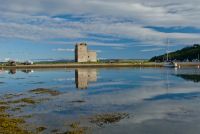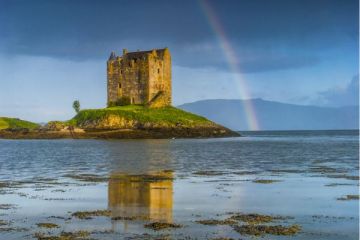
History
In its original form, Lochranza Castle stood two storeys high, with a small ground floor entrance to a storeroom, accessed under a 'murder hole'; a trapdoor through which the castle defenders could hurl missiles or shoot arrows on attackers beneath. Historic Scotland calls this ground-floor entrance a 'tradesman's entrance'.
The main castle entrance was at first-floor level on the seaward side, reached by an internal timber stair with three barriers controlling access. The main entrance gave access to the lord's lodging.
The earliest castle at Lochranza was probably built by Dougal MacSween, the Lord of Knapdale. MacSween was the son of Suibhne (Sven) âthe Redâ, and was also responsible for Skipness Castle, across Kilbrannan Sound on the mainland. Neither castle was his main residence, however; that was Castle Sween. Historical records suggest that it was held by the Campbells as early as 1315.

Sometime in the late 16th century the medieval castle was enlarged and strengthened, possibly by a member of the Stewart family of Menteith, or by the Montgomery earls of Eglinton, who held northern Arran in the late 1500s.
The expanded castle completely changed its layout; the main entrance was now at ground level, on the landward side. A third storey was added to the main block, with a five-story wing, to create a traditional L-plan tower house. A watch tower stood on the roof of the wing.
The main entrance gives access to a turnpike stair, with a secondary stair built into the wall itself. The main block has a vaulted basement which holds the castle kitchen and a storage area. This is the only vaulted part of the castle.
A third stair led to the hall, but this was sealed at a later date. The hall has a raised dais at one end, and a hatch to a pit prison.
Lochranza Castle is said to have been visited by Robert Bruce before he left Arran for his ultimately successful bid for the Scottish throne. It was later used as a hunting lodge by the Scottish monarchy.

In the 1490s Lochranza Castle was used by James IV as part of his successful attempts to suppress the MacDonald Lords of the Isles. The castle was briefly occupied by troops under James VI in 1614, and later by soldiers under Oliver Cromwell. In 1705 the castle was sold to Anne, Duchess of Hamilton. It was described as in decay by the late 18th century. It is now in the care of Historic Environment Scotland (formerly Historic Scotland).
The castle is in a ruinous state, though the outer shell provides a wonderfully scenic picture, rising above the waters of the loch. The remains stand three storeys high, with an attic level, and a south wing rising another two storeys.
If you arrive early enough in the morning you may find a local herd of deer coming down to the loch to drink and graze, and the combination of the deer and the castle is such a marvellous and totally 'Scottish' picture!
Getting There
Lochranza Castle is hard to miss! It is in Lochranza village, on the A841 coastal road at the northern tip of Arran. There is free parking available.



 We've 'tagged' this attraction information to help you find related historic attractions and learn more about major time periods mentioned.
We've 'tagged' this attraction information to help you find related historic attractions and learn more about major time periods mentioned.


